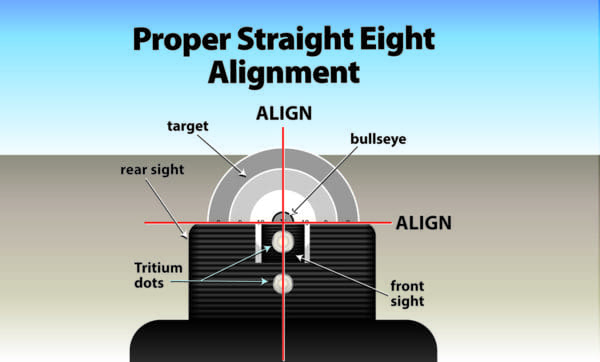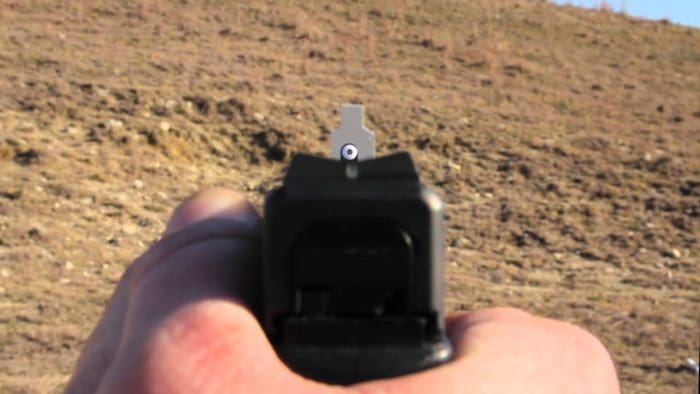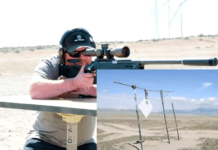While the notion of eye dominance is important in shooting, it’s generally overrated. Especially for new shooters, it’s much more important to learn the proper way to align and see your sights and not worry about seeing them with the “proper” eye. At least at first.
Seeing properly is the key
Everyone has an eye preference, a tendency to look primarily through your sights with one eye or the other. If you’re right handed and right eye dominant (or vice versa), you don’t have to worry about a thing.
If you’re cross-dominant, that can complicate things for a new shooter, but there are ways around that. You can close the eye opposite your strong hand or you can adjust your hold slightly to align your handgun with you dominant eye.
The point is, even if you’re you’re dealing with cross-dominance, it ultimately has very little to do with learning to be a good shooter. The more important question is, does the shooter know how to see and use their front sight. Do they know specifically what they’re looking for and how to view the object of their focus.
Concentrate on what you’re seeing, not how
When using binocular (both eyes open) vision, there’s an effect called parallax. Each eye has a slightly different view of the world. That’s what gives us depth perception. The brain tends to rely on the dominant eye for more precise positional information, something that’s important in shooting.
Some trainers will try to get a new or novice shooter to immediately identify their dominant eye as if it’s the primary key to good marksmanship. Instead of worrying which eye is dominant, they should be more concerned with where the shooter is looking. Not knowing what to focus on is the most common sighting error we see in students…no matter which eye is dominant.
I spend a great deal of time helping students focus on aligning their sights and getting them to see the the square shape over the round shape in their front sight. It’s more important for them to learn to see the front sight that it is for them to worry about how they’re seeing it.

As for how to do that, I have a couple of tricks up my sleeve. My go-to tip was shown to me by my shooting coach when I was on the junior national pentathlon team. He would have me stretch out a piece of string about 10 yards with knots at various distances.
He would then have me focus on each knot staring with the farthest. Then I’d alter my focus, concentrating on each knot all the way in to my front sight.
These days I take a different approach with newer shooters. I ask them to extend their arm, then focus their vision on various features of their arm beginning a few inches out, gradually moving all the way out to their finger tip. I ask them to focus intently on these features (hairs, freckles, tattoos) to the point they can describe each of them to me in detail.
It’s awesome when a student comments that learning to visually walk down their arm toward their finger is what helped them finally draw their focus out to their front sight post.
Master the basics first
When I find a student is having difficulty focusing and shooting accurately with both eyes open, my solution is simple. I have them close one eye.
If they’re a right handed shooter, I have them close the left eye. By eliminating the eye dominance issue altogether, the student is able to concentrate on the principles of marksmanship.
Learning how to shoot accurately with one eye closed and and gaining confidence in properly using their sights seems simple. But believe it or not, many beginners and even a few intermediate students have difficulty with this seemingly simple task.

Do I want students to eventually shoot with both eyes open? Of course. But I find it’s much more valuable for newer shooters to learn how to use their sights correctly and to start to shoot accurately. Then, once they have the basics down, they can work their way up to shooting with binocular vision.
When we minimize distractions and increase concentration as it relates to sight focus, the results speak for themselves. In short, you don’t need to know which eye is dominant early on. You can worry about that after you’ve learned how to use and see your sights properly. Then we can deal with any cross-dominance issues.
Jeff Gonzales is a former US. Navy SEAL and preeminent weapons and tactics instructor. He brings his Naval Special Warfare mindset, operational success and lessons learned to the world at large. He is the president of Trident Concepts in Austin, Texas.





I used my left eye, right handed, until my cataract surgery, now the right eye is better then the left. So I’ve gotta learn my style of shooting all over.
One thing is nice I don’t get the concussion from having my head tilted like I used to.
Not as fast with a long arm as I used to be either, I shot them left handed.
I hear ya possum…waiting on cataract surgery(HMO sux). I can only see out of my right eye with glasses. We’ll see!
I’ve had cataract surgery on both eyes, one when I was 50 and the other at 52. Best thing I ever did for myself.
lol 😀
Both eyes done 3 months ago — I’m 76. Brightness and clarity, REAL colors, all unbelievably wonderful. Now trying to not look like I’m squinting all the time with no glasses. Still need reading glasses as lenses are single vision (Medicare limit)..
This is awesome practical tech.
As a question it seems handgun specific. What about rifles?
I’m cross eye dominant. Pistols are really no big deal. Rifle is a bit more annoying. I trained myself to close either eye, so I can shoot rifle right-handed with a good cheek weld while using my non-dominant (also right) eye. I will never be a crack rifle shot because I simply don’t see well enough from my non-dominant eye, but I do well enough. Optics, of course, help a lot, but iron sights are more fun.
One thing I tried (I didn’t love it, but some people like it okay) was to put a piece of translucent scotch tape over the left lens of one of my old pairs of glasses. This will block your vision in one or the other eye, making it a lot easier to get a sight picture on your non-dominant eye. It works well enough, but is a little distracting. I prefer just closing my eye instead.
I suppose I could also learn to shoot left handed. Maybe someday…
I’ve never had the problem of shooting left handed or right handed with a scope, but I don’t wear glasses either. A shotgunm I shoot left handed, a pistol right handed and a head tilt.
I’m retraining to shoot right handed right eyed because my right eye is better then my left now.
Great reading! Does it also apply to cross-dressers, transgenders, and non binary shooters?
Only of they’re cross eye dominant, I would think.
What if they’re cockeyed?
Then you use a periscope.
are you kidding ? 😀
I’m transgender non-binary and I am right eye dominant when it comes to shooting my pocket pistol at the range.
Part way through my first enlistment, I figured out I’m lefteye dominant and started shooting shoulder-fired weapons that way. It made shooting with both eyes open much easier and made transitioning to my pistol faster too, because the shoulder-fired would naturally fall to the left.
I swing a bat left-handed, for the same reason I suspect.
Same here. I am right handed, for shooting found out early on my left eye was stronger. Fortunately firing left handed was natural for me. Never needed a left handed firearm however. Bat left handed, throw left handed. Use either hand as needed with tools. Strictly right handed with writing. And, being able to use either hand improves my sex life.
I’m cross-eye dominant and have no problems with handguns. I’ve trained myself to use my other eye for rifles. I shoot both handguns and rifles with both eyes open.
Irons, peeps, and beads both eyes open. Scopes I close one eye if it’s at a longer distance. Acquisition target with both eyes open, close one eye, take a deep breath, let half out, then close both eyes and yank the death toggle.
That’s how I do it.
possum:
“…then close both eyes (etc.)…”
You’re putting me on!
I had PRK. It’s a form of Lasik that’s much more gruesome but no flap so the structure of your eye remains intact. PRK was something that the military approved for pilots that had ejection seats. No Lasik flaps to become dislodged. Lasik severely lessens the strength of the eyeball, that flap only heals around the edge of the flap or you would be blind. Lasik is not approved for pilots who might have to eject. (fighter pilots)
“In general, PRK is acceptable, but LASIK is considered disqualifying for active duty in any Special Forces (air, sea or land) capacity, and for naval aviators.”
That all being said when you have refractive surgery (laser), you have to remember that eventually you will lose your near vision just like everybody else. This can actually be overcome with a procedure called monovision. Your non dominant eye is set slight nearsighted and your dominant eye is set at the best possible correction. You will be 20/40 in the eye (non dominant) that is set to nearsighted and 20/15-20/20 in your dominant eye. No readers if it works until you need cataract surgery and then you get multifocal IOLs which are not cheap and are not covered by Medicare or insurance.
The thing is that it isn’t great for shooting. Both eyes open you want the clearest view of your sights and the other eye set for distance. Enter reverse monovision. You don’t have to have Lasik or PRK to do this, many shooters do this with glasses or contacts. Your dominant eye is set nearsighted, you get a great sight picture and your non dominant eye is set for distance. Some peoples brains can adapt to this, some other people not. The best way is to wear glasses or contacts for a month and see if you get headaches. They can be bad. If so then you are not a candidate for monovision or reverse monovision.
I liked the idea of this and as I type this my right eye (my dominant eye) is reading what I type and I don’t notice that I have to squint the left eye to see some of the smaller stuff on the monitor. It all becomes moot in shooting because as after a certain distance your eyes should work in stereo or binocular vision.
Also find a surgeon/ophthalmologist that is familiar with this if you are going to have refractive surgery. My doc was an avid shotgun shooter and had his eyes set up the same way. It affected my shooting for a while but I needed vision correction that wasn’t a hassle. I was sick of glasses and contacts but you would be surprised at the amount of competitive shooters who have glasses or contacts set up this way.
Remember: Not all peoples brains can process this visually so you might not be able to do it.
If you can, it’s almost like cheating.
SSP Eyewear is another way to achieve that without surgery. You can get shooting glasses with the bifocal at the top of the lens. And then you can mix and match with a bifocal at the top for one eye and a bifocal at the bottom for the other eye.
Great article, great comments. Thanks
But it would also be easier to start teaching earlier on to use the other hand. Would be harder to train with the non dominant hand after they become used to using dominant hand with non dom eye.
Nice article
https://mechanicalboost.com/
Comments are closed.